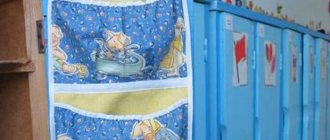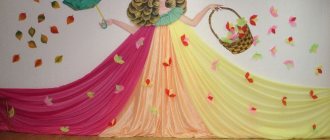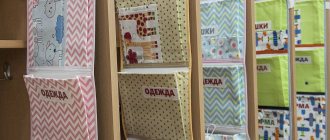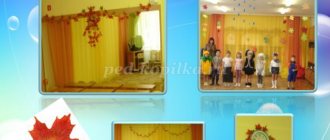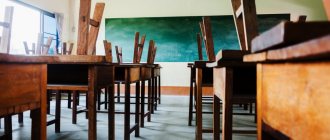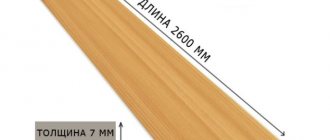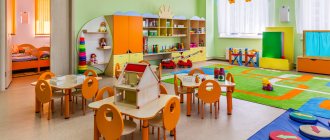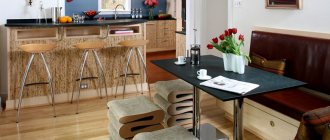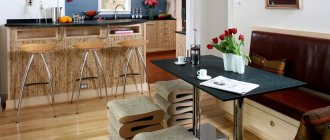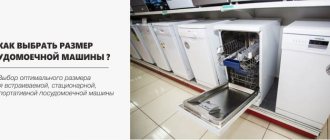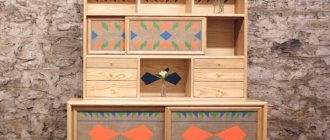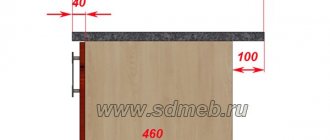SanPiN for kindergartens — assistant teacher in organizing work with children. Each preschool employee must know the basic provisions of sanitary norms and rules and follow them. Legislatively approved standards are designed to ensure a comfortable stay for children in kindergarten and their safety. The article will talk about the rules for color marking furniture and accessories for preparing (storing) food products in accordance with generally accepted abbreviations.
General requirements
Children spend most of their free time in groups, and this has a great influence on the formation of their psyche and health in general.
The external environment and setting matter. Furniture requirements:
- Strength. No breakage, deformation, delamination, formation of dust or splinters. The products are strong enough to support the weight of several people.
- Ecological cleanliness. The materials do not contain harmful substances that can cause the development of allergies and other diseases. This applies to conditions of contact with detergents, high temperatures and moisture.
- Ergonomics. Convenient for short and long term use. The child should be comfortable sitting, lying, standing, reaching or placing something.
- Durability. The budget of preschool institutions is not unlimited. They are often unable to change furniture, and using old, worn-out and unsafe furniture is prohibited by law.
- Nice appearance. The environment should have a positive effect on the children’s mood and evoke a feeling of peace. There are rules regarding shapes and colors.
- Suitable for the child's height. The health of the musculoskeletal system, digestion and even the functioning of the cardiovascular system depend on the correctly selected dimensions of furniture.
The arrangement of kindergartens is under strict state control. For violation of GOST and SanPiN requirements, product manufacturers may be held financially liable in the form of a fine with confiscation of goods that do not meet the standards.
Height groups of school and preschool furniture
Height groups
During training sessions working posture for a long time . This load increases sharply if the furniture is arranged and its size does not correspond to height and proportions .
Conditions arise that contribute to poor posture, the development of myopia and its progression. Therefore, the correct furnishing of schools is determined by the availability of the necessary sets of student furniture in accordance with the actual distribution of children by height groups (this is of particular importance in primary schools). Fulfillment of these requirements is ensured by the purchase of furniture of different heights or height-adjustable furniture .
To select the correct height group for student tables and chairs, it is necessary to take into account the height of the students. Try to use the information below when selecting furniture for your classroom.
Scheme of height school groups
In accordance with this height scale, GOST 11015-71 “Student’s tables” and 11016-71 “Student’s chairs” provide for the production of four groups of furniture. This distribution of schoolchildren into growth groups and the production of a specific number of furniture for each of them will ensure a comfortable workplace for schoolchildren.
Separately, it is necessary to pay attention to furniture with adjustable height , it allows you to significantly save money , it is purchased once, and subsequently, as the child grows, it is only adjustable in height .
Scheme of growth preschool groups
Requirements for school furniture
School furniture must meet pedagogical, sanitary and hygienic, ergonomic, production and economic, architectural and artistic requirements. Another thing worth mentioning is the requirement of durability.
Equipping a school with furniture is a serious task for school management, which, in addition to certification requirements, must take into account the direct number and age of students in the educational institution. It cannot be allowed that there is not enough furniture for children or older schoolchildren, because the requirements for tables and chairs assume that they are selected for students according to their height. In addition to the general requirements, there are also those that are determined by expediency - school furniture must be collapsible, otherwise transporting large quantities will make it very expensive.
Among the special requirements for school furniture are those that relate to specialized products, for example, for physics, chemistry classrooms, computer classes, for children with posture problems who need to study while standing part of the time.
If we talk about the formal side of the issue, the main requirement of state standards for school furniture is the requirement of height compliance, established since 1972, in which a height scale was introduced with an interval of 15 centimeters. Later, in 1986, a refined system of growth groups was introduced, of which there were six, as well as color marking of products. This marking corresponds to the global standard for furniture for schools: ISO 5970 “Furniture. Tables and chairs for educational institutions.”
In 1992, GOST standards for school furniture were once again clarified and approved (“School furniture. Functional dimensions”). From then until now they have not changed. Apparently, no fundamental changes are expected in them in the near future. Since 1994, school furniture has been required to undergo certification.
List of current GOSTs:
GOST 11015, GOST 11016, GOST 5994, GOST 18314, GOST 18313, GOST 19549, GOST 19550, GOST 22359, GOST 18607.
While studying in schools, universities and other educational institutions, students spend most of their time at their desks, which is why it is important that student furniture is made taking into account all sanitary standards. Also, much attention should be paid to the quality of school furniture and furniture for preschool institutions . It is high-quality school furniture that can ensure injury safety for your children. School desks should have rounded corners and a smooth surface. The future health of your children largely depends on how comfortably your child sits while completing assignments in class. Therefore, when selling school furniture, the ALI LAND company takes into account all the developmental features of the child’s body.
Manufactured school furniture is produced in accordance with GOST 22046-2002 “Furniture for educational institutions. Technical specifications”, which comes into force on July 1, 2003. Thus, all the requirements for school furniture . All school furniture supplied by us is certified and safe for children.
Hygienic requirements for school furniture.
Study furniture should be made of hard wood, its surface should not be too rough or, on the contrary, mirror-smooth. It is possible to finish the table and chair seat with transparent varnish while preserving the wood texture or painting with opaque coatings in the following colors: yellow, light green, bluish-green, grayish-blue, light blue, greenish-yellow with a reflectance of 35 to 50%. The surface should be matte, since shiny surfaces of tables, cabinets and other equipment have a blinding effect on the retina, causing a decrease in visual acuity, speed of discrimination, stability of clear vision and a decrease in performance. You cannot paint tables and cabinets in dark colors, as they will absorb a large amount of light and negatively affect the psycho-emotional state of children. It is not allowed to paint school equipment white, as this sharply increases the brightness and glare level in the room.
Desks or tables in the classroom are arranged in rows (usually 3 rows) so that the light falls from the left side, while maintaining the established distances. In classrooms of a regular rectangular configuration, these distances are as follows: from the outer wall to the first row (counted from the window) at least 0.6 - 0.7 m, from the inner wall to the third row - 0.5 m, from the back wall to the last tables (desks) – 0.5 – 0.65 m, from the chalkboard to the first tables (desks) – at least 2 m (optimally 2.4 – 2.7 m), between rows – 0.6 – 0.7 m The distance from the windows to the third row of tables should be no more than 6 m, since otherwise the workplaces of students sitting in this row will be poorly illuminated by natural light. The back desks should be located no more than 8 m from the blackboard , since their further removal causes excessive strain on the students' vision and hearing.
Classification
There are three types of furniture depending on its purpose:
- Basic or work furniture : chairs, school desks, blackboards, laboratory tables, workbenches, machines, etc.
- Accessory furniture: cabinets, sideboard, hangers, benches, etc. Furniture for sleeping and relaxing (for 6-year-old children): beds, folding beds, etc.
- Furniture for schools and other children's institutions must correspond to the age-related anatomical and physiological characteristics of children. Furniture and equipment should be easy to clean and have a smooth surface with rounded edges; their design should eliminate the possibility of injury to children during learning and recreation. The external design of furniture should be attractive. The design of furniture should be strong, stable, simple, reliable.
Rationale for correct posture
The educational process is associated with great mental and physical stress . Working at a desk , drawing board , standing at a workbench are associated with a certain, predominantly static position of the body, causing tension in the muscles of the back, neck, abdomen, upper and lower extremities. The posture control system includes the central nervous system (corresponding segments of the spinal cord) and peripheral receptors in the muscles; Posture control is carried out through the muscular system, thanks to tremor - slight trembling of the muscles. Poses with a slight inclination are more beneficial from the point of view of statics and biomechanics - less fluctuation in the center of gravity. With large bends, additional motor units are involved in the work, the pulse quickens, the breathing amplitude decreases, visual disturbances are possible, congestion occurs in the bloodstream of the legs and pelvis, and compression of the spinal discs occurs.
It has been established that the degree of inclination of the body increases with the age of schoolchildren: in the elementary grades between the inclination of the head and the horizontal plane is 45 degrees, the thoracic spine is 55 degrees. For middle and high school students, respectively - 39 - 33 and 53 -48 degrees. Age-related characteristics of the sitting position are associated with anatomical and physiological parameters of the body. The less perfect structure of the neuromuscular system at primary school age explains the difficulties of overcoming static loads, despite the more vertical position of the body.
Pose Evaluation Criteria
To assess a student’s posture, various criteria are used that take into account the characteristics of the physiology and pathology of children.
- Physiological criteria: degree of activity of the muscular system, stability of posture, minimal deviation of the center of gravity from the balance point, which makes the sitting position of the body more advantageous compared to a standing one. The body position is considered correct if stable balance and normal activity of the cardiovascular system, respiratory, digestive systems, auditory and visual analyzers are maintained. When writing, the least tiring posture is when the center of gravity is between the X - XI vertebrae, with the plumb line passing behind the hip joint. The head is slightly tilted forward, the back is straight, the shoulder girdle is in the horizontal plane - all this significantly reduces muscle tension and prevents early fatigue. When reading, a more relaxed posture is used, with more forward leaning. Based on the degree of bending of the body, poses with a small, medium and large inclination are distinguished. Poses with low bends include bending the thoracic part of the spine in relation to the lumbar spine at an angle of 170 degrees and tilting the head at 50 degrees. With an average posture inclination, these values approach 160 and 40 degrees, respectively. In applications with a large slope - less than 150 and 30 degrees, respectively. In school workshops, the posture should be rational, taking into account safety precautions.
- Pathophysiological criteria: asymmetry of posture and corresponding asymmetry of muscle tone, as well as excessive tilts of the body, which arise due to prolonged static loads and improper arrangement of furniture, which can lead to a number of complications - such as myopia, scoliosis, kyphosis, osteochondrosis.
- Psychophysiological criteria: subjective feeling of comfort of the posture - lack of pressure in the ischial region and back of the thighs, visual comfort (especially in computer classes).
Correct posture
When writing , the least tiring posture is when the center of gravity is between the X - XI vertebrae, with the plumb line passing behind the hip joint. The head is slightly tilted forward, the eyes are at a distance of the length of the forearm and the extended palm to the notebook sheet, the back is straight, the shoulder girdle is in a horizontal plane, the body is moved 3 - 5 cm from the desk. When reading, a more relaxed posture is used, with more forward leaning. When working in the workshop - straight or slightly inclined position of the body with a slight tilt of the head, even distribution of body weight on the right and left halves of the body, avoiding compression of the chest and abdominal cavities, and visual fatigue.
Selection of furniture
Carried out in accordance with GOST 11015-77 “Student tables” and GOST 11016-77 “Student chairs”.
Table 1.
| Furniture group | Student height, cm | Height of the rear edge of the seat above the floor, cm | Height of the front edge of the seat above the floor, cm | Marking color | Differentials, cm |
| A | up to 130 | 54 | 32 | Yellow | 22 |
| B | 131-145 | 60 | 36 | Red | 24 |
| IN | 146-160 | 66 | 40 | Blue | 26 |
| G | 161-175 | 72 | 44 | Green | 28 |
| D | above 175 | 78 | 48 | White | 30 |
Height is determined by medical records, the results of which are entered annually - before the start of the school year, or height is determined directly in the medical record. school office. The seating arrangement is also carried out taking into account the individual state of vision and hearing of each child.
The height of the carpentry workbench is determined as follows. The student stands sideways to the workbench and places his palm on it; if there is no bending at the elbow joint, then this workbench is suitable for this student. The vice is selected in such a way that when placing the elbow on the vice, the fingers touch the chin.
Furniture design
Desks.
In recent decades, separate desks and chairs , which has its advantages (easier rearrangement, the possibility of individual selection of table and chair , especially for single desks) and disadvantages (possibility of incorrect seating). The dimensions of desks and chairs are presented in the table. 2 and tab. 3 applications respectively. The height of the chair seat is the length of the lower leg plus 1 - 2 cm for the heel. The width of the seat is the size of distantia bitrochanterica plus 3 - 4 cm, the depth of the seat is 2/3 - 3/4 of the length of the thigh. The vertical distance between the rear edge of the table and the seat is called differentiation (elbow length plus 2 - 2.5 cm) - characterizes the relative position of the table and chair in the vertical plane; the distance between the front edge of the chair and the vertical projection of the rear edge of the table is called the distance and characterizes the relative position of the table and chair in the horizontal plane. The distance can be zero (the edge of the chair and the projection of the rear edge of the table coincide), positive (the projection lies outside the plane of the chair) and negative (the projection is on the plane of the seat) ; but it is the latter position that encourages the student to sit correctly with support on the back. Research has shown that the optimal distance is 3 - 5 cm. The surface of the table should be matte and not glare, with a reflection coefficient of 35-55%.
Blackboard
There are two main types of chalkboards : wall-mounted and mobile. The main hygienic requirements for the board are to facilitate the visual work of schoolchildren. The color of the board coating is green, dark brown, matte black (reflection coefficient of at least 80%). The most physiological color is dark green in combination with the bright yellow color of chalk. For drawing rooms, it is recommended to use boards with white chalk. The boards covered with various types of linoleum, but recently boards with the possibility of using magnetic aids (thin-layer steel coated with glass enamel, glass ceramics, synthetic films or paints). To prevent chalk from contaminating the floor, a tray is attached to the board , which is also used for storing chalk. In the first 4 grades, the board should be installed so that the bottom edge is at a height of 80-85 cm, and in senior grades - at a height of 90-95 cm. Mobile boards are placed in such a way that they do not reflect and, preferably, not blocked the main board . The boards are wiped with damp boards or sponges soaked in warm water.
Drawing tables
Drawing tables are equipped in drawing rooms in specialized schools; usually these are tables with a variable tilt of the lid; at a tilt of 30° - for drawing, and at 60° for drawing.
Laboratory furniture
Laboratory tables (GOST 18314-73 “Student and laboratory tables. Types and main dimensions.”), demonstration tables , fume hoods are intended for equipment of physical and chemical laboratories . The working surface of the table for one student is at least 120´ 60 cm. Tables in three groups: B - for height 145-160 cm; G - 160-175 cm; D - for height over 175 cm.
Furniture in workshops
School workshops , in addition to a variety of machines, are equipped with workbenches with vices. To prevent impairment of physical development (in the form of deterioration of posture and vision, etc.), it is necessary to take into account the student’s height, as well as his physiological position at work (see above). For individual selection of a workbench and machine, benches and stands .
Dining room furniture
They use dining tables of lightweight construction, easy to clean, with pull-out stools. The table legs are made from welded pipes, the ends of which are fitted with plastic tips.
Computer classroom furniture
Specially converted desks with an increased surface area of the table top, or special tables for computers . As seats, it is recommended to use specially designed swivel chairs or chairs with a large backrest and a bolster in the lumbar region, because The most rational pose is with the body tilted slightly back to reduce eye and back fatigue.
APPENDIX Table 2 Student tables. Types and functional dimensions (GOST 11015-77)
Group table dimensions, mm | |||||
| Indicator name | A | B | IN | G | D |
| Table cover length: single double | 600 1200 | 600 1200 | 600 1200 | 600 1200 | 600 1200 |
| Cover width | 450-500 | 450-500 | 450-500 | 450-500 | 450-500 |
| Table height from the seated side | 540 | 600 | 660 | 720 | 780 |
| Distance from the back edge of the table to the recess for the handle, not less | 400 | 400 | 400 | 400 | 400 |
| Distance from the rear edge of the table to protruding structures in front of the knees, not less | 300 | 300 | 300 | 340 | 340 |
| Roof overhang width, no more | 10 | 10 | 10 | 10 | 10 |
| Vertical distance from the floor to protruding structures above the knees | 450 | 510 | 570 | 630 | 690 |
Table 3 Student chairs. Types and functional dimensions (GOST 11016-77)
Dimensions of group chairs, mm | |||||
| Indicator name | A | B | IN | G | D |
| Seat front height | 320 | 360 | 400 | 440 | 480 |
| Seat width | 270 | 310 | 340 | 360 | 380 |
| Seat depth | 260 | 290 | 320 | 350 | 380 |
| The height of the lower edge of the backrest above the seat | 120 | 135 | 150 | 165 | 180 |
| Back height | 60-120 | 70-135 | 80-150 | 90-150 | 100-180 |
| Back width | 240 | 270 | 300 | 320 | 340 |
| Bend radius of the front edge of the seat | 20-50 | 20-50 | 20-50 | 20-50 | 20-50 |
| Back bend radius | 80-100 | 80-100 | 80-100 | 80-100 | 80-100 |
| Seat angle | 0-3 | 0-3 | 0-3 | 0-3 | 0-3 |
| Backrest angle | 102-108 | 102-108 | 102-108 | 102-108 | 102-108 |
LIST OF REFERENCES AND MATERIALS
Healthcare of Kazakhstan: magazine No. 3, 1986 \ I. P. Petrishche A method for determining furniture groups of new GOSTs.
Hygiene: textbook R. D. Gabovich, S. S. Poznansky, G. Kh. Shakhbazyan. M: “Medicine” 1971
Hygiene of children and adolescents: textbook by V. N. Kardashenko, E. P. Stromskaya and others. M.: Medicine, 1988.
General hygiene: textbook G. I. Rumyantsev, E. P. Vishnevskaya, T. A. Kozlova. M.: Medicine, 1985.
Peculiarities of children's physiology: study. manual edited by prof. V. M. Smirnova. M.: 1993
Lectures on hygiene course.
Selection of tables and chairs
Places for eating, playing, and learning activities are arranged in such a way that the child has correct posture and normal blood circulation. The main focus is on security issues. The corners are rounded, the backs of the chairs are high enough to support the upper body. The countertops are large enough to accommodate elbows, albums and utensils.
Since children of different ages go to kindergartens, the groups are equipped with furniture of appropriate sizes. In total, four standards have been developed and are in force, designed for children of a certain height. They are the same for institutions in all regions of the country, regardless of their level and property rights.
These requirements are regulated by SanPiN 2.4.1.3049-13. Heads of preschool institutions need to monitor changes in legislation, as it is periodically revised in order to improve the comfort of children.
Requirements for chairs and tables:
- While sitting on a chair, the child’s legs rest firmly and tightly on the floor and do not hang.
- The front edge of the seat is not adjacent to the popliteal hollows.
- The back rests against the back of the chair with the lower back and shoulder blades.
- Elbows rest freely on the tabletop at right angles.
This position prevents discomfort and fatigue, helps maintain activity, alertness, and the proper formation of the musculoskeletal system.
Requirements for beds
Recreation areas should be comfortable and safe. For the manufacture of beds, only materials of natural origin are used, which do not contain substances harmful to health.
The frame is made from solid wood: pine, spruce, maple, poplar. The material is treated with a primer and antiseptic. It is allowed to use high quality laminated MDF, chipboard (class E1), and marine plywood.
The edges and edges of the products are rounded. Coloring can be done with water-based compounds. The bed frames are equipped with stiffening ribs that prevent uneven compression of the mattress. Sides are placed along the edges with a sufficient height to prevent the child from falling to the floor while sleeping.
The soft part is made of cotton wool or special foam rubber. Mattresses are made moderately hard to prevent curvature of the spine during rest. Mattress covers are made of natural fabric with water-repellent impregnation. The use of synthetics and rubber-based materials is not allowed.
Types of structures
Before choosing templates or determining the optimal dimensions that a closet, table or bed should have, you need to get acquainted with the available design options.
Today we are talking about beds. If you choose a bed for your child, then without any problems you can take your favorite bunk bed-table or some transforming models.
See also
Choosing a loft bed with a work area and wardrobe design options
For kindergarten beds, there are more stringent and regulated requirements. We will consider the list of these standards according to GOST a little later. I suggest starting with the varieties of available designs. What kind of beds there should be is decided not only by the head of the preschool institution, but also by the selection rules approved by the government. You can’t just use a photo or a picture in a manufacturer’s catalog to purchase furniture for several dozen children.
I'll tell you right away. For children, it is recommended to choose wooden furniture options, since this is the most environmentally friendly and safe material.
Yes, designs based on wood derivatives are often found. These are chipboard, plywood, MDF and other similar materials. Here you will have to more carefully check their composition and the absence of harmful components.
As for the varieties, there are several main options.
Each of them has its own characteristics. Mainly offered for kindergartens:
[adv1]
- sliding models are suitable for those kindergartens where there is no separate bedroom, and often have drawers, built-in chests of drawers, and special mattresses;
- single-tier, complemented by sides or protective backs;
- kaleidoscope beds;
- stackable;
- roll-out beds;
- bunk cribs;
- double-row with a partition between them;
- three-tier;
- roll-out three-tier;
- roll-out beds.
Yes, there really are many options. But in fact, single-tier options are most often purchased for kindergartens.
Multi-tiered systems raise too many questions regarding their security component.
Requirements for lockers
For each child, in the locker room , which is signed and marked with a personal drawing.
The cells are made of durable materials that are resistant to corrosion, dampness, the development of fungus and mold, as well as insect infestation. The fittings are made of metal that can withstand heavy mechanical loads and a long period of operation. Each drawer has shelves for shoes and hats. At least two hooks for outerwear are installed. There should be no sharp ends or edges that could injure your hand.
Long and stable benches are placed next to the rows of cells, on which it will be convenient for children to put on and take off their shoes.
Shelves for books and toys are made in an open design without hinged or lifting doors. The products are securely fixed to the floor and walls to eliminate the slightest risk of them falling on children.
Characteristics of SMD resistor
SMD resistors are manufactured by various companies. Therefore, the characteristics of elements with the same rating can differ greatly from each other. There are several basic parameters that you need to pay attention to.
The power rating requires special attention. For surface mount resistor designs, the level of power that can be dissipated is less than for wirewound components.
Due to the fact that SMD resistors are made using a metal oxide film, they have relatively similar tolerance values. However, deviations within 5, 2 and 1 percent are the most common. For special parts the values can be 0.5 and 0.1 percent.
SMD resistors usually have a good temperature coefficient. Values of 25, 50 and 100 units of pulse modulation per 1°C are most common.
Requirements for upholstered furniture
Upholstered furniture in kindergartens is used in limited quantities, as it quickly gets dirty, and cleaning the upholstery from dirt is quite problematic.
Usually a corner is set up in which a small sofa, a pair of armchairs and ottomans are installed. Products must meet the following conditions:
- Sustainability. It is impossible to turn them over or knock them over during use.
- Strength. Thick upholstery, immunity to chemical and organic substances.
- Fire safety. Non-flammable, no toxic emissions upon contact with fire.
- Nice appearance. Selecting a color and configuration that children like and fits organically into the interior of the group.
- Composition that does not contain substances that cause allergies.
Furniture is made to order or purchased from retail outlets that comply with the rules of its production.
Labeling furniture for kindergarten
The marking of furniture in a kindergarten is an alphanumeric designation that contains information about the technical characteristics. It is applied in a specific color corresponding to the height group of the users.
The marking contains the following information:
- product name;
- manufacturer's company logo;
- manufacturer country;
- legal address of the factory;
- date of manufacture;
- guarantee period;
- estimated service period.
If the product is sold assembled or is monolithic, a label with the designation is attached to its body. When products are sold disassembled, the markings on a piece of fabric or paper are placed together with assembly instructions in the container.
